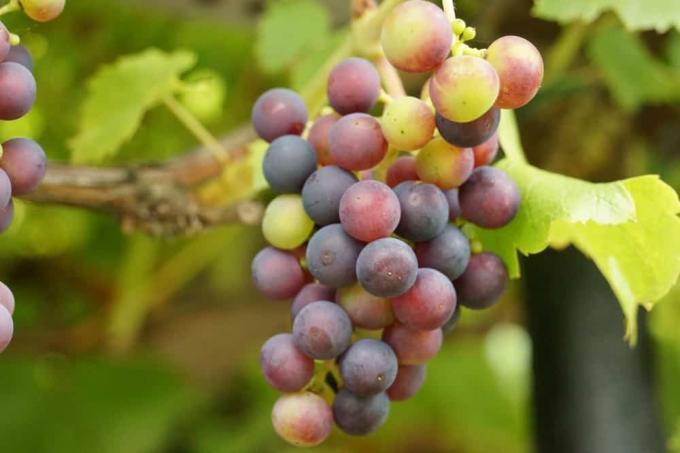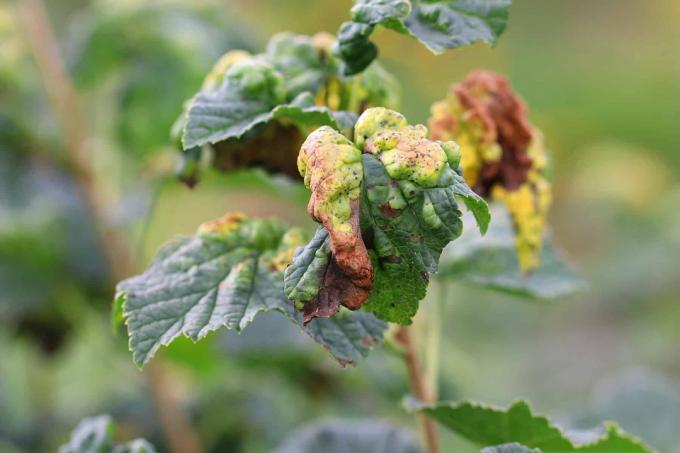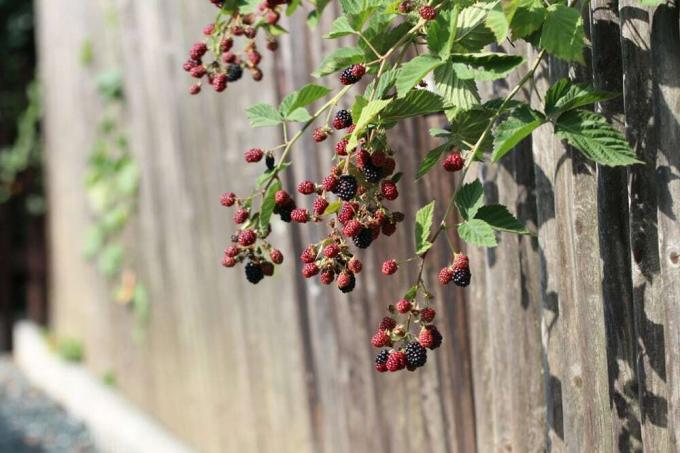

Table of contents
- Some of the most important varieties for the home garden
- The grape seeds must be of perfect quality
- Prepare the kernels properly
- seeds plants
- Transplant seedlings
- Planting the seedlings outdoors
- If you want to harvest, patience is required
- Grapes in the bucket
- frequently asked Questions
- Things to know about planting vines in a nutshell
Have you always wanted to grow grapes from seeds yourself? The vine plant is not only useful but also very beautiful and one of the oldest cultivated plants. Here are some tips on how and with which grapes success can be achieved in your own garden.
Some of the most important varieties for the home garden
There are thousands of grape varieties in the world. Below are some robust grape varieties that also thrive in the home garden and sometimes under adverse conditions. Phoenix is a robust, vigorous grape variety that is considered a table grape. It thrives best on sunny southeast and west faces. The grape is fungus-tolerant, has no special demands on the soil and is resistant to flowering, which also makes it suitable as a pergola greening in a wind-exposed location.
- the sort Nutmeg bleu comes from a Swiss breed and is an ideal table grape for the home garden, which is occasionally also pressed in Switzerland. Southeast and west walls are perfect. The plant is very robust against pests such as mildew and is perfect for pergola greening as well as for free standing in a sunny and wind-protected environment.
- The regent is an offspring from the wine grape. The robust and moderately vigorous vine is suitable for south-east and west faces. It is fungus and mildew tolerant. The grape, which is also frost-resistant, is very suitable as a container plant.
- The Palatina is a table grape for sunny south-east or west-facing walls, for the pergola or fence or even for a single post, which is robust. Birstaler Muskat is a universal table grape that is particularly popular in commercial organic table grape cultivation because it has a has very high resistance to fungi and is also well suited for humid areas with high humidity - for example in northern Germany is. Due to its robustness, it can also be kept under glass or the foil tent. The grape also thrives very well in open-air locations.
- The Teresa is originally a late-ripening Hungarian breed. It is fungus tolerant and can be grown on south or west walls without intense shading and in a sheltered location. The grape is also suitable for pergola greening in sunny and wind-protected locations.
- The esther is a fungus-tolerant, Hungarian breed that brings early grape ripening. This grape easily tolerates rather disadvantaged places and unfavorable climatic conditions such as in northern Germany or at high altitudes as well as outdoors. In addition, the Esther brings with it a high level of frost hardness.
The grape seeds must be of perfect quality
In order for the planting of the vine plant to be successful, the seeds must be of optimal quality. It is easy to see that the cores are in good condition. To check the quality, the cores are first pressed lightly between the fingers. A good and healthy core then feels firm. A visual assessment is also important for the quality check. A healthy grape seed has a white or pale gray so-called endosperm that shines through under the skin. A water test also provides information about the core quality. If you put the kernels in water, the healthy kernels will sink to the bottom. Consequently, any floating cores can be discarded immediately since they will not sprout. Viable seeds can be recognized by:
- Firmness when pressed between fingers
- white or pale gray sheen through the shell
- sinking in a water bowl (floating nuclei no longer germinate)
Prepare the kernels properly
The selected healthy and germinable seeds are now washed and thoroughly cleaned of dirt and pulp residues. Then the seeds are soaked in a small pot with distilled water for 24 hours. Especially with grapes, some seeds need a cold period and relatively humid climatic conditions before they start the germination process. In nature, the core automatically gets these important conditions by spending the winter in the ground. But you can also offer the core the perfect conditions for domestic germination. Stratification is the word for success here. This means the targeted cold treatment within botany.
December is the best time to start stratification. First, a bed must be prepared for the cores. This is done by filling an airtight bag or other container with a soft surface such as paper towels, sand, compost, or moistened peat. Peat is the most favorable basis, because it has fungicidal properties and prevents the formation of mold on the cores. Now the cores are filled into the prepared bed and covered with about 1.5 cm of soil. Perfect temperatures for stratification are 1 to 3 °C, so the fridge is the perfect place to store them. The kernels are now stored in their cold bed for two to three months. Attention: They must not freeze under any circumstances!
seeds plants
In the spring, the seeds are removed from their prepared bed to be planted in pots filled with quality soil. The kernels should be placed individually in smaller pots or alternatively in larger containers, and then several cores are placed in the larger vessels at a distance of at least four centimeters from each other become. Once used, the cores must be kept warm. For optimal germination, the seeds need a day temperature of at least 20 °C and a minimum temperature of 15 °C at night. A greenhouse offers perfect conditions for germination. The soil must be kept moist, but not too wet, for the seeds to germinate. Wetting with a fine jet of water when the surface appears dry is best. A lot of patience is required during this phase, because the cores only float after two to eight weeks.
Transplant seedlings
When the seeds have reached seedlings about 8 cm high, they are transplanted into larger pots. For seedlings to grow vigorously, they should be kept indoors or in a greenhouse until they are 30 cm tall and have about five to six leaves. Only then are the seedlings mature enough to be transplanted into the ground.
Planting the seedlings outdoors
– Site, Drainage, Support –
When the seedlings are transplanted outdoors, the choice of location as well as the choice of soil are very important. Wine needs an optimal dose of sun, i.e. no shade, but also no constant, intense sunlight. Seven to eight hours of full sun are enough for the vine plant. The ground must be well prepared. Wine needs a drained soil. If the subsoil is clay or poorly drained soil, the subsoil should be Compost, sand or other soil-improving additives can be enriched to allow drainage is optimized.

A raised bed that is filled with a mix of sand and compost is also well suited for the wine. The individual plants must be placed at a distance of 2.5 cm. As climbing plants, vine plants must be supported. This requires scaffolding or some other stable support. In the first year of growth, sticks are enough to support the delicate vine plant so that it is held up off the ground. Later, the plants need a stable support to which they are attached with wire.
If you want to harvest, patience is required
It takes patience to cultivate the vine plant in order to obtain a harvest of fruit. The vine plant takes up to three years of growth before it starts producing fruit. For an optimal harvest, the right care is necessary during this time. In the first year, only the three strongest shoots of the plant should remain, all others are removed. This supports the growth of the strongest shoots. In the second year, a so-called balance fertilizer should be used. Inflorescences should now be removed, because the vine wastes energy if inflorescences develop too early. All buds and shoots below the three main shoots should be removed. In the third year, fertilization is continued and deep buds and shoots are removed, but the inflorescences can remain in the meantime. A small grape harvest can already take place this year. From the fourth year, the plant is fertilized and cut.
Grapes in the bucket
A vine can also be cultivated in a bucket on the terrace. But then he needs a large pot with a volume of at least 30 liters, because the plant forms very deep roots. A good supply of water and nutrients is also important. The fertilizer should contain little nitrogen, because this only promotes the growth of the leaves, while phosphorus is more important for a rich harvest of grapes. In winter, vines in a bucket need protection against the cold. Then the bucket is wrapped in bubble wrap or fleece and the plant must be watered every now and then on frost-free days so that the pot ball does not dry out completely.
frequently asked Questions
No, grape seeds can even be kept within the stratification for years, because during this time they are simply dormant, but are then always capable of germination.
If the seeds don't sprout on the first try, they can simply be put back into the stratification and left to germinate for the next season.
Things to know about planting vines in a nutshell
location and planting time
- Grapes grow best on a warm, south-facing house wall where they are sheltered from the wind.
- You need a trellis, wires or ropes along which the shoots are guided.
- This climbing aid should be about 3 m high, because the vines grow quickly in a good location and, depending on the variety, several meters per year.
- If several vines are planted next to each other, they need a distance of 2 to 3 m from each other.
- Although grapes can be planted all year round, the leafless period from autumn to spring is best.
- The ideal planting time is early spring, when the heaviest frosts are over.
- In mild locations, planting can start as early as mid-March, in areas where late frosts often occur, April is more suitable.
Plant
The planting hole for the vine should be about twice as deep and as wide as the root ball so that the soil is well loosened and the vines can easily put down new roots. However, the lower part is filled with potting soil again so that the vines protrude from the ground at the same height as they were in the pot before.
- It is important that the grafting point remains a few centimeters above the surface of the earth.
- The grapes do not tolerate waterlogging, so very dense soil is made more permeable with some gravel or sand before planting.
- The distance to the house wall should be about half a meter so that there is enough space for the root system.
- After planting, they are watered abundantly and the newly planted vines must be watered regularly in the weeks that follow.
It is helpful to create a watering rim around the plants. For this purpose, some earth is piled up around the trunks so that the water cannot run off to the sides.
 garden editorial
garden editorial I write about everything that interests me in my garden.
Learn more about soft fruit

Leaf diseases on currants: leaf fall disease & Co
Diseases on the leaves are not uncommon in currants. They are triggered by fungi, viruses or various pests settle in. Many problems can be remedied with simple home remedies. Proper care also helps to prevent many diseases.

10 good neighbors of raspberries | mixed culture
Raspberries should grow healthily for several years and bring us a rich harvest every time. Choosing a good neighborhood helps to achieve this goal. But with whom does the berry plant like to share the bed and with whom not?

Honeyberry, Lonicera kamtschatica: 12 tips on location & care
In the local latitudes, the robust honeyberry can be cultivated and propagated well, as it does not make great demands on the site conditions and care measures. If you pay attention to certain factors when planting and cutting, you can already harvest sweet fruits in spring.

Cultivated blueberries: 4 important location criteria
The blueberry offers delicious fruits and is a visually appealing tree. However, the cultural form of the blueberry differs greatly from the demands on its location compared to its wild relatives. In the right location, cultivated blueberries can yield several kilos.

Blackberry location: 4 important criteria
Blackberries are a popular sweet fruit that is easy to care for. With a suitable location, plant health is guaranteed and the yield can be increased. The right location depends on the type of variety, because not every blackberry is insensitive to low temperatures.

Fighting lice on currants | 8 home remedies to get rid of aphids
When the first leaves appear on the currants in spring, there are often aphids on the bushes. The small insects are hidden under the leaves and can quickly cause a lot of damage. Therefore, lice should be combated at an early stage, ideally with natural home remedies.


